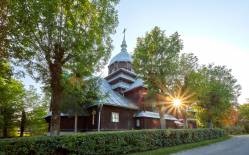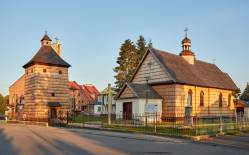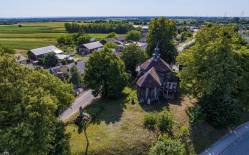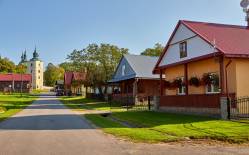The wooden Greek-Catholic tserkva of Sobor of the Mother of God was built during 1923−1926 at a location of an older church from 1777. It was built in a village of Kormanice, which no longer exists but in those times was a neighbour to Fredropol, a town established by Andrzej Maksymilian Fredro.
After Ukrainians were relocated from here in the 1940s it was used by the Roman Catholic community, and in 1961 was consecrated as the church of Nativity of the Blessed Virgin Mary.
The log church, oriented eastward, comprises three parts including a sanctuary, enclosed with semi-hexagonal walls and on both sides adjoined by rectangular pastoforia. The most distinctive feature is the octagonal drum sitting on top of a base structure with skirt roofs running at three heights; the drum is covered with a shapely dome topped with a false lantern. The nave and the narthex are covered with two-pitched roofs, the sanctuary with a five-pitched and the pastoforia with mono-pitched roofs. The interior, partly altered, is covered with a flat ceiling.
The belfry has a rectangular floor plan, the longer side is aligned with east-west direction. It is covered with a pyramidal roof with a slender octagonal turret on top. The upper floor along its perimeter features a row of openings created by posts and angle braces. The wooden post-and-beam belfry, comprising a single-span chamber, holds two bells.
On the slope of a nearby hill called Łysa Góra there is an old place of worship known as Zjawlinia. A legend says that a girl picking herbs at this site saw an apparition of the Holy Mother. Her footprint was impressed on a stone. Before the Greek Catholics were resettled from this area, a tserkva of Macarius the Martyr stood here. The stone with the footprint was placed under the altar. It is said that there were a few attempts to bring the stone to Kormanice, but each time it returned here in a mysterious way.
Photo: Krystian Kłysewicz
Gallery

Recommended venues on the Trail



This website has been modernized with the financial support of the European Union under the Cross-Border Cooperation Programme Poland-Belarus-Ukraine 2014-2020. The responsibility for its content lies solely with the Podkarpackie Regional Tourism Board and cannot, in any case, be treated as a reflection of the position of the European Union, the Managing Authority, or the Joint Technical Secretariat of the Cross-Border Cooperation Programme Poland-Belarus-Ukraine 2014-2020.













